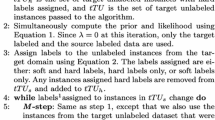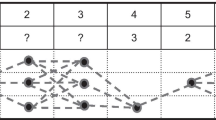Abstract
A challenge arising from the ever-increasing volume of biological data generated by next generation sequencing technologies is the annotation of this data, e.g. identification of gene structure from the location of splice sites, or prediction of protein function/localization. The annotation can be achieved by using automated classification algorithms. Supervised classification requires large amounts of labeled data for the problem at hand. For many problems, labeled data is not available. However, labeled data might be available for a similar, related problem. To leverage the labeled data available for the related problem, we propose an algorithm that builds a naïve Bayes classifier for biological sequences in a domain adaptation setting. Specifically, it uses the existing large corpus of labeled data from a source organism, in conjunction with any available labeled data and lots of unlabeled data from a target organism, thus alleviating the need to manually label a large number of sequences for a supervised classifier. When tested on the task of predicting protein localization from the composition of the protein, this algorithm performed better than the multinomial naïve Bayes classifier. However, on a more difficult task, of splice site prediction, the results were not satisfactory.
Access this chapter
Tax calculation will be finalised at checkout
Purchases are for personal use only
Similar content being viewed by others
Notes
- 1.
Downloaded from http://www.psort.org/dataset/datasetv2.html
- 2.
Downloaded from http://www.cbs.dtu.dk/services/TargetP/datasets/datasets.php
- 3.
Downloaded from ftp://ftp.tuebingen.mpg.de/fml/cwidmer/
References
Baten, A., Chang, B., Halgamuge, S., Li, J.: Splice site identification using probabilistic parameters and SVM classification. BMC Bioinform. 7(Suppl. 5), S15 (2006)
Bernal, A., Crammer, K., Hatzigeorgiou, A., Pereira, F.: Global discriminative learning for higher-accuracy computational gene prediction. PLoS Comput. Biol. 3(3), e54 (2007)
Brown, M.P.S., Grundy, W.N., Lin, D., Cristianini, N., Sugnet, C., Furey, T.S., Ares Jr., M., Haussler, D.: Knowledge-based analysis of microarray gene expression data using support vector machines. PNAS 97(1), 262–267 (2000)
Dai, W., Xue, G., Yang, Q., Yu, Y.: Transferring naïve bayes classifiers for text classification. In: Proceedings of the 22nd AAAI Conference on Artificial Intelligence (2007)
Degroeve, S., Saeys, Y., De Baets, B., Rouzé, P., Van De Peer, Y.: Splicemachine: predicting splice sites from high-dimensional local context representations. Bioinformatics 21(8), 1332–1338 (2005)
Eaton, J.W., Bateman, D., Hauberg, S.: GNU Octave Manual Version 3. Network Theory Ltd., Bristol (2008)
Emanuelsson, O., Nielsen, H., Brunak, S., von Heijne, G.: Predicting subcellular localization of proteins based on their N-terminal amino acid sequence. J. Mol. Biol. 300(4), 1005–1016 (2000)
Gardy, J.L., Laird, M.R., Chen, F., Rey, S., Walsh, C.J., Ester, M., Brinkman, F.S.L.: Psortb v. 2.0: Expanded prediction of bacterial protein subcellular localization and insights gained from comparative proteome analysis. Bioinformatics 21(5), 617–623 (2005)
Gardy, J.L., Spencer, C., Wang, K., Ester, M., Tusnády, G.E., Simon, I., Hua, S., deFays, K., Lambert, C., Nakai, K., Brinkman, F.S.: Psort-b: improving protein subcellular localization prediction for gram-negative bacteria. Nucleic Acids Res. 31(13), 3613–3617 (2003)
Huang, J., Li, T., Chen, K., Wu, J.: An approach of encoding for prediction of splice sites using svm. Biochimie 88, 923–929 (2006)
Jaakkola, T.S., Haussler, D.: Exploiting generative models in discriminative classifiers. In: Proceedings of the 1998 Conference on Advances in Neural Information Processing Systems II, pp. 487–493. MIT Press, Cambridge (1999)
Jiang, J., Zhai, C.: A two-stage approach to domain adaptation for statistical classifiers. In: Proceedings of the Sixteenth ACM Conference on Information and Knowledge Management, CIKM ’07, pp. 401–410. ACM, New York (2007)
Lorena, A.C., de Carvalho, A.C.P.L.F.: Human splice site identification with multiclass support vector machines and bagging. In: Kaynak, O., Alpaydın, E., Oja, E., Xu, L. (eds.) ICANN/ICONIP 2003. LNCS, vol. 2714, pp. 234–241. Springer, Heidelberg (2003)
Maeireizo, B., Litman, D., Hwa, R.: Co-training for predicting emotions with spoken dialogue data. In: Proceedings of the ACL 2004 on Interactive Poster and Demonstration Sessions, ACLdemo ’04. Association for Computational Linguistics, Stroudsburg (2004)
Mccallum, A., Nigam, K.: A comparison of event models for naive bayes text classification. In: AAAI-98 Workshop on ‘Learning for Text Categorization’ (1998)
Müller, K.-R., Mika, S., Rätsch, G., Tsuda, S., Schölkopf, B.: An introduction to kernel-based learning algorithms. IEEE Trans. Neural Networks 12(2), 181–202 (2001)
Nigam, K., Mccallum, A., Thrun, S., Mitchell, T.: Text classification from labeled and unlabeled documents using EM. Mach. Learn. 39(2–3), 103–134 (1999)
Noble, W.S.: What is a support vector machine? Nat Biotechnol. 24(12), 1565–1567 (2006)
Pan, S.J., Yang, Q.: A survey on transfer learning. IEEE Trans. Knowl. Data Eng. 22(10), 1345–1359 (2010)
Rätsch, G., Sonnenburg, S.: Accurate splice site detection for caenorhabditis elegans. In: Schölkopf, B., Tsuda, K., Vert, J.-P. (eds.) Kernel Methods in Computational Biology, pp. 277–298. MIT Press, Cambridge (2004)
Rätsch, G., Sonnenburg, S., Srinivasan, J., Witte, H., Müller, K.-R., Sommer, R., Schölkopf, B.: Improving the c. elegans genome annotation using machine learning. PLoS Comput. Biol. 3, e20 (2007)
Riloff, E., Wiebe, J., Wilson, T.: Learning subjective nouns using extraction pattern bootstrapping. In: Proceedings of the Seventh Conference on Natural Language Learning at HLT-NAACL 2003, CONLL ’03, vol. 4, pp. 25–32. Association for Computational Linguistics, Stroudsburg (2003)
Schölkopf, B., Smola, A.J.: Learning with Kernels: Support Vector Machines, Regularization, Optimization, and Beyond. MIT Press, Cambridge (2001)
Schweikert, G., Widmer, C., Schölkopf, B., Rätsch, G.: An empirical analysis of domain adaptation algorithms for genomic sequence analysis. In: NIPS’08, pp. 1433–1440 (2008)
Sonnenburg, S., Rätsch, G., Jagota, A., Müller, K.-R.: New methods for splice site recognition. In: Dorronsoro, J.R. (ed.) ICANN 2002. LNCS, vol. 2415, pp. 329–336. Springer, Heidelberg (2002)
Sonnenburg, S., Schweikert, G., Philips, P., Behr, J., Rätsch, G.: Accurate splice site prediction using support vector machines. BMC Bioinf. 8(Suppl. 10), 1–16 (2007)
Tan, S., Cheng, X., Wang, Y., Xu, H.: Adapting Naive Bayes to domain adaptation for sentiment analysis. In: Boughanem, M., Berrut, C., Mothe, J., Soule-Dupuy, C. (eds.) ECIR 2009. LNCS, vol. 5478, pp. 337–349. Springer, Heidelberg (2009)
Tsuda, K., Kawanabe, M., Rätsch, G., Sonnenburg, S., Müller, K.-R.: A new discriminative kernel from probabilistic models. Neural Comput. 14(10), 2397–2414 (2002)
Vapnik, V.N.: The Nature of Statistical Learning Theory. Springer-Verlag New York Inc., New York (1995)
Yarowsky, D.: Unsupervised word sense disambiguation rivaling supervised methods. In: Proceedings of the 33rd Annual Meeting on Association for Computational Linguistics, ACL ’95, pp. 189–196. Association for Computational Linguistics, Stroudsburg (1995)
Zhang, Y., Chu, C.-H., Chen, Y., Zha, H., Ji, X.: Splice site prediction using support vector machines with a bayes kernel. Expert Syst. Appl. 30(1), 73–81 (2006)
Zien, A., Rätsch, G., Mika, S., Schölkopf, B., Lengauer, T., Müller, K.-R.: Engineering support vector machine kernels that recognize translation initiation sites. Bioinformatics 16(9), 799–807 (2000)
Acknowledgements
The computing for this project was performed on the Beocat Research Cluster at Kansas State University, which is funded in part by NSF grants CNS-1006860, EPS-1006860, EPS-0919443, and MRI-1126709.
Author information
Authors and Affiliations
Corresponding author
Editor information
Editors and Affiliations
Rights and permissions
Copyright information
© 2014 Springer-Verlag Berlin Heidelberg
About this paper
Cite this paper
Herndon, N., Caragea, D. (2014). Predicting Protein Localization Using a Domain Adaptation Approach. In: Fernández-Chimeno, M., et al. Biomedical Engineering Systems and Technologies. BIOSTEC 2013. Communications in Computer and Information Science, vol 452. Springer, Berlin, Heidelberg. https://doi.org/10.1007/978-3-662-44485-6_14
Download citation
DOI: https://doi.org/10.1007/978-3-662-44485-6_14
Published:
Publisher Name: Springer, Berlin, Heidelberg
Print ISBN: 978-3-662-44484-9
Online ISBN: 978-3-662-44485-6
eBook Packages: Computer ScienceComputer Science (R0)




